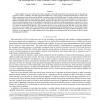Free Online Productivity Tools
i2Speak
i2Symbol
i2OCR
iTex2Img
iWeb2Print
iWeb2Shot
i2Type
iPdf2Split
iPdf2Merge
i2Bopomofo
i2Arabic
i2Style
i2Image
i2PDF
iLatex2Rtf
Sci2ools
ICNP
2002
IEEE
2002
IEEE
An Investigation of Inter-Domain Control Aggregation Procedures
Current Quality of Service models such as those embodied in the Differentiated Services proposals, rely on data path aggregation to achieve scalability. Data path aggregation bundles into a single aggregate multiple individual flows with the same quality requirements, hence decreasing the amount of state that needs to be kept along a path. A similar scalability concern exists on the control path, where the state required to account for individual reservations needs to be minimized. There have been a number of proposals aimed at control path aggregation, and the goal of this report is to expand on these works in an attempt to gain a better understanding of the various parameters that influence the efficiency of different approaches. In particular, we focus on inter-domain control aggregation, and compare an Autonomous System (AS) sink-tree based approach with several examples of a shared AS segment based approach. The comparison is done in terms of the amount of state that is kept, ...
| Added | 14 Jul 2010 |
| Updated | 14 Jul 2010 |
| Type | Conference |
| Year | 2002 |
| Where | ICNP |
| Authors | Rute Sofia, Roch Guérin, Pedro Veiga |
Comments (0)

